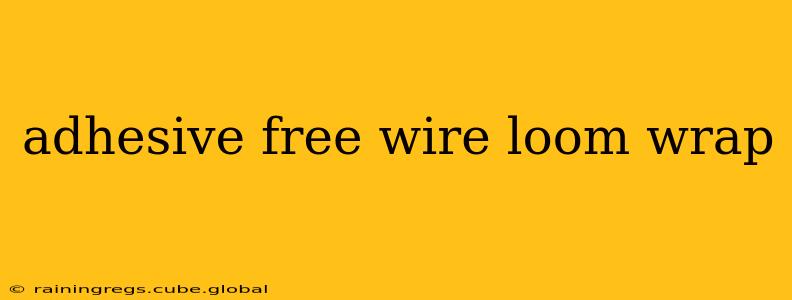Choosing the right wire loom wrap is crucial for organizing and protecting your wiring harnesses. While adhesive-backed options are common, adhesive-free alternatives offer several advantages. This guide explores the benefits, types, and applications of adhesive-free wire loom wrap, answering common questions to help you make an informed decision.
What is Adhesive-Free Wire Loom Wrap?
Adhesive-free wire loom wrap, unlike its adhesive counterpart, doesn't rely on glue or sticky backing for installation. Instead, these wraps utilize various mechanisms to secure themselves around wires, offering a clean, reusable, and often more versatile solution. They are ideal for situations where adhesive residue is undesirable or where you might need to adjust or reuse the loom.
What are the Different Types of Adhesive-Free Wire Loom Wrap?
Several types of adhesive-free wire loom wraps exist, each with its own strengths and weaknesses:
-
Spiral Wraps: These are perhaps the most common type. They consist of a flexible, often plastic, material that's wound around the wires. The spiral design allows for expansion and contraction, accommodating changes in the wire bundle's size. They are easy to install and remove, making them ideal for temporary applications or situations requiring adjustments.
-
Braided Sleeving: This type of wrap uses braided fibers, often nylon or polyester, to create a flexible and durable protective sheath. The braiding action keeps the sleeving tightly around the wires without adhesive. Braided sleeving is often more resistant to abrasion and chemicals than spiral wraps.
-
Split Loom Tubing: This option comes as a tube that's slit lengthwise, making it easy to install and remove around the wires. The slit allows it to conform to various shapes and sizes of wire bundles. It's often a cost-effective solution, particularly for larger bundles.
-
Hook and Loop Wraps: These wraps use hook and loop fasteners to secure themselves around the wiring harness. They are extremely easy to install and remove, ideal for temporary applications or situations where access to the wires might be necessary. However, they might not offer the same level of protection as other types.
What are the Advantages of Adhesive-Free Wire Loom Wrap?
Using adhesive-free wire loom wrap offers several key advantages:
-
Reusability: Many adhesive-free options can be easily removed and reused, saving time and materials. This is particularly beneficial for prototyping, testing, or situations where the wiring harness might need adjustments.
-
Clean Installation: No messy adhesive means no residue left behind, keeping your project clean and professional-looking. This is critical in sensitive environments or applications where cleanliness is paramount.
-
Versatility: Adhesive-free wraps often offer greater flexibility in terms of application and adjustments to the wire bundle size.
-
Cost-Effectiveness (in some cases): While some premium options can be more expensive, simpler adhesive-free wraps, particularly split loom tubing, can often be more cost-effective than adhesive versions, especially for larger projects.
What are the Disadvantages of Adhesive-Free Wire Loom Wrap?
While offering numerous advantages, adhesive-free options have some potential drawbacks:
-
Potential for Loosening: Depending on the type and the application, the wrap might loosen over time, especially in situations involving vibrations or movement.
-
Limited Protection (in some cases): Some adhesive-free wraps might offer less protection against abrasion, chemicals, or moisture compared to certain adhesive options or heavy-duty braided sleeving.
How Do I Choose the Right Adhesive-Free Wire Loom Wrap?
The best adhesive-free wire loom wrap for your project depends on several factors:
-
Application: Consider the environment (indoor/outdoor, harsh chemicals, vibration), the need for reusability, and the level of protection required.
-
Wire Bundle Size and Shape: Ensure the wrap can accommodate the size and shape of your wiring harness.
-
Material: Choose a material compatible with the operating conditions and any potential environmental factors.
-
Budget: Consider the cost of the wrap in relation to its performance and longevity.
What are Some Common Applications of Adhesive-Free Wire Loom Wrap?
Adhesive-free wire loom wraps are used in a vast array of applications, including:
-
Automotive: Organizing and protecting wiring harnesses in vehicles.
-
Electronics: Protecting circuits and wiring in electronic devices.
-
Robotics: Protecting and organizing wiring in robotic systems.
-
Aviation: Used in aerospace applications where reliability and cleanliness are crucial.
-
Industrial Automation: Protecting and organizing wiring in industrial machinery.
Is Adhesive-Free Wire Loom Wrap Suitable for Outdoor Use?
Yes, but the choice of material is critical. Some materials are more resistant to UV degradation, moisture, and extreme temperatures than others. Look for wraps specifically designed for outdoor use. Braided sleeving made from UV-resistant materials is often a good choice for outdoor applications.
By carefully considering these factors, you can select the ideal adhesive-free wire loom wrap to meet your specific needs and ensure the proper protection and organization of your wiring harnesses. Remember to always check the manufacturer's specifications to confirm suitability for your application.
